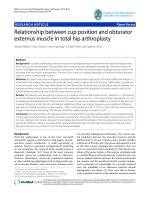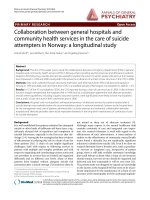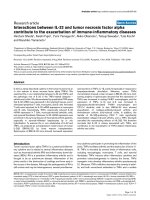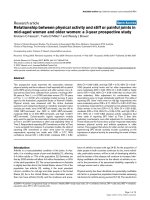Báo cáo y học: " Relationship between anal symptoms and anal findings"
Bạn đang xem bản rút gọn của tài liệu. Xem và tải ngay bản đầy đủ của tài liệu tại đây (2.03 MB, 8 trang )
Int. J. Med. Sci. 2009, 6
77
I
I
n
n
t
t
e
e
r
r
n
n
a
a
t
t
i
i
o
o
n
n
a
a
l
l
J
J
o
o
u
u
r
r
n
n
a
a
l
l
o
o
f
f
M
M
e
e
d
d
i
i
c
c
a
a
l
l
S
S
c
c
i
i
e
e
n
n
c
c
e
e
s
s
2009; 6(2):77-84
© Ivyspring International Publisher. All rights reserved
Research Paper
Relationship between anal symptoms and anal findings
Hans Georg Kuehn
1
, Ole Gebbensleben
2
, York Hilger
3
, Henning Rohde
1
1. Praxis für Endoskopie und Proktologie, Viktoria-Luise-Platz 12, 10777 Berlin, Germany
2. Park-Klinik Berlin-Weissensee, Innere Abteilung, Schönstrasse 80, 13086 Berlin, Germany
3. Bertholdstrasse 1 - 3, 79098 Freiburg, Germany
Correspondence to: Prof. Dr.med. Henning Rohde, , Praxis für Endoskopie und Proktologie, Vik-
toria-Luise-Platz 12, 10777 Berlin. ++493036440226.
Received: 2009.01.18; Accepted: 2009.03.03; Published: 2009.03.06
Abstract
Background: The frequencies and types of anal symptoms were compared with the fre-
quencies and types of benign anal diseases (BAD).
Methods: Patients transferred from GPs, physicians or gynaecologists for anal and/or ab-
dominal complaints/signs were enrolled and asked to complete a questionnaire about their
symptoms. Proctologic assessment was performed in the knee-chest position. Definitions of
BAD were tested in a two year pilot study. Findings were entered into a PC immediately
after the assessment of each individual.
Results: Eight hundred seven individuals, 539 (66.8%) with and 268 without BAD were ana-
lysed. Almost one third (31.2%) of patients with BAD had more than one BAD. Concomi-
tant anal findings such as skin tags were more frequently seen in patients with than without
BAD (<0.01). After haemorrhoids (401 patients), pruritus ani (317 patients) was the second
most frequently found BAD. The distribution of stages in 317 pruritus ani patients was: mild
(91), moderate (178), severe (29), and chronic (19). Anal symptoms in patients with BAD
included: bleeding (58.6%), itch (53.7%), pain (33.7%), burning (32.9%), and soreness (26.6%).
Anal lesions could be predicted according to patients’ answers in the questionnaire: haem-
orrhoids by anal bleeding (p=0.032), weeping (p=0.017), and non-existence of anal pain
(p=0.005); anal fissures by anal pain (p=0.001) and anal bleeding (p=0.006); pruritus ani by
anal pain (p=0.001), itching (p=0.001), and soreness (p=0.006).
Conclusions: The knee-chest position may allow for the accumulation of more detailed
information about BAD than the left lateral Sims’ position, thus enabling physicians to make
more reliable anal diagnoses and provide better differentiated therapies.
Key words: haemorrhoids, pruritus ani, fissure-in-ano, thrombosed external haemorrhoid, benign
anorectal diseases, Sims’ position, knee-chest-position
Introduction
Patients suffering from any symptoms related to
the anus frequently and often incorrectly assume that
their symptoms are due to haemorrhoids [1,2,3,4].
Lockhart-Mummery once wrote "nearly every lesion
around the anus is liable to be called 'piles' by the
patient and not infrequently by the referring doctor
also" [5]. This practice still prevails: "Almost everyone
suffers from haemorrhoids at some time in their lives"
[6]. "Haemorrhoids and their symptoms are one of the
most common afflictions in the western world" [7].
The exact incidence of haemorrhoids is unknown
as estimates vary [1,6,8,9]. In the US about 1.5 million
prescriptions for anorectal preparations are written
yearly [10]. The cost of treating benign anal diseases
(BAD) in the United States exceeds 2 billion dollars
annually [11].The German National Insurance Fund
Int. J. Med. Sci. 2009, 6
78
spends 38 million Euros yearly for ointments and
suppositories whose use is not supported by any sci-
entific data [12].
History taking does not lead to accurate anal
diagnoses [1,13]. It is also unknown which examina-
tion position (i.e. left-lateral, knee-chest, lithotomy or
the upright standing-bented) is the most reliable for
determining the causes of anal bleeding, anal itch,
anal pain or anal burning. The sensitivity, specificity
and predictive value of patients’ positioning in diag-
nosis of BAD, concomitant anal findings (CAF), and
multiple anal lesions (MAL) with one individual also
remain unknown [3,14,15]. We investigated the types
and frequencies of anal complaints with respect to
anal findings at proctologic assessment using the
knee-chest position in contrast to the widely used left
lateral Sims’ position to evaluate its pros and cons.
Methods
Participants
Individuals were asked to complete a question-
naire that described their symptoms and signs (table
1). Proctologic assessment was performed in the
knee-chest position [14] by inspection of the anal
verge followed by digital examination of the anal ca-
nal, and anoscopy. Colono-, sigmoido- or rectoscopy
were performed if necessary.
Table 1: Patients’ questionnaire with given answers
1. Which symptom, sign or cause prompted you to seek help in
our outpatient clinic? (Mark as many items as apply)
anal bleeding - in toilet paper, faeces or lavatory
anal itch
anal pain or discomfort
anal burning (baking)
anal soreness
anal lump
faecal soiling
anal weeping
anal mucous
anal incontinence
dubious abdominal pain
constipation
diarrhoea
faecal occult blood test (FOBT)
dubious anaemia
screening colonoscopy
elevation of tumour markers
2. How long have you suffered from these symptoms or signs?
up to one week
two to four weeks
two to twelve months
I do not have any signs or symptoms
3. Did you treat yourself or seek help from a doctor?
I treated myself without the help of a doctor
At first I treated myself then I looked for help from a doctor
I immediately looked for help from a doctor
Definitions
We used published definitions for BAD such as
haemorrhoids (table 2) and pruritus ani (table 3).
Concomitant anal findings (CAF) such as skin tags
were defined as anal verge anatomical findings of
unknown importance for BAD (table 4). Multiple anal
lesions (MAL) were defined as more than one BAD
found in one individual e.g. a fissure-in-ano with
pruritus ani [14,15]. Definitions were tested in a two
year pilot study, and adopted into routine use ten
months before start of the study. Findings were en-
tered into a personal computer immediately after
proctologic assessment of each individual.
Table 2: Definitions of benign anal diseases (BAD)
Anal lesion [Ref-
erence]
Definition, Illustration
Haemorrhoids [13] "Haemorrhoids (or piles) are displaced anal
cushions. Haemorrhoids should not be diag-
nosed unless prolaps or bleeding is a dominant
symptom, in conjunction with visible dis-
tended or displaced anal cushions on ano-
scopy." (figure 1)
Fissure-in-ano [16] "A fissure is a split in the lower half of the anal
canal extending from the anal verge toward
the dental line." (figures 2 and 3)
Thrombosed ex-
ternal haemorrhoid
[13]
"Localised thrombosis which may affect the
external plexus". (figure 4)
Figure 1: Protruding haemorrhoids combined with skin
tags around the anus (definitions table 2 and table 4).
Figure 2: Chronic anterior anal fissure, diameter of
5-8mm, combined with a leftlateral thrombosed external
haemorrhoid (definitions table 2).
Int. J. Med. Sci. 2009, 6
79
Figure 3: Posterior cavity, diameter 10x5mm, representing
an old chronic anal fissure which has healed as indicated by
a blanket of an epithelial layer.
Figure 4: Non perforated leftlateral thrombosed external
haemorrhoid (definition table 2), diameter 10 – 15 mm with
an anterior skin tag (definition table 4).
Table 3: Definition of four stages of pruritus ani according
to Mazier[1], Nagle[10], Brossy[17], Gayle[18], Granet[19],
Mentha[20], Fazio[21], Tucker[22], and Smith[23].
Grading Terms, Definitions, Illustrations
mild stage 1 No lesion seen at inspection of anal verge but the
patient finds palpation and/or anoscopy painful, and
other anal lesions have been excluded (figure 5).
moderate stage 2 Red dry skin only (figure 6), at times weeping
skin with superficial round splits and longitudinal su-
perficial fissures. (figure 7).
severe stage 3 Reddened, weeping skin, with superficial ulcers
and excoriations disrupted by pale, whitish areas with
no more hairs (figures 8 and 9).
chronic stage 4 pale, whitened, thickened, dry, leathery, scaly
skin with no hairs and no superficial ulcers or excoria-
tions (figures 10 and 11).
Figure 5: Unremarkable (normal) anal verge with hairs
shaved (tiny black spots around the anus).
Figure 6: Red dry skin with bleeding spots (stage 2 of
pruritus ani, definition table 3) at a patient with a hairy anus
(definition table 4).
Figure 7: Weeping anal skin with superficial round splits
and longitudinal superficial lesions (stage 2 of pruritus ani,
definition table 3) at everted distal anal canal. Normally the
distal anal canal is closed so that these tiny, passing lesions
are not seen. Lesions diameter: 1 – 3 mm.
Int. J. Med. Sci. 2009, 6
80
Figure 8: Reddened, weeping skin, with superficial ulcers
and excoriations disrupted by pale, whitish areas with no
more hairs (stage 3 of pruritus ani, definition table 3).
Figure 9: Red superficial lesions situated in whitish areas of
anal skin covering skin tags situated around the anus (stage 3
of pruritus ani, definition table 3).
Figure 10: Pale, whitened, thickened, dry, leathery, scaly
skin with no hairs and no superficial ulcers or excoriations
(stage 4 of pruritus ani, definition table 3).
Figure 11: Whitish, pale, dry anal skin at anal verge in-
cluding thickened, leathery surrounding skin tags (stage 4 of
pruritus ani, definition table 3).
Table 4: Definition of concomitant anal findings (CAF)
found at inspection of anal verge during proctologic as-
sessment
Concomitant anal
findings (CAF):
Terms [References]
Definitions / Illustrations
Skin tags[13] "Skin tags are hypertrophied redundant folds
of perianal skin" (figures 1,4,9,11).
Funnel shaped
anus[24]
"The buttocks are permanent in touch with
each other and have to be parted firmly to be
able to inspect the anal verge" (figures 12 and
13).
Hairy anus[24] "Hairs spread out almost carpet like to the anal
verge" (figures 6 and 14).
Figure 12: Funnel shaped anus the buttocks being per-
manent in touch. They leave if parted a brownish border at
its extreme edges (definition table 4).
Int. J. Med. Sci. 2009, 6
81
Figure 13: Funnel shaped anus. A red anterior border
indicates its extreme edges. Skin tags, a longitudinal split at
rima ani indicates local inflammation (stage 2 of pruritus
ani).
Figure 14: Hairy anus. Hairs spread out almost carpet like
to the anal verge (definition table 4).
Statistics
Means +/- standard deviation were computed
for continuous variables such as age. Frequencies and
percentages were calculated for categorical data such
as the male to female ratio, history of symptoms, and
anal lesions. Bivariate analyses were performed by
using t-tests to compare independent groups and
point-biserial correlations coefficients to analyse rela-
tionships between continuous and dichotomous
variables. Bivariate relationships between pairs of
dichotomous variables were analysed with Fisher’s
exact test. P-values of <0.05 were considered statisti-
cally significant. Binary logistic regression analysis
was used to predict anal lesions based on answers of
the patient questionnaire. Data were analysed using
the Statistical Package for Social Sciences software
(SPSS, Chicago, Il) version 15.
Results
A total of 876 individuals of both genders aged
16 – 80 years old who consecutively entered our office
from July 25, 2005 until December 20, 2005 were en-
rolled. They were referred by general practitioners,
physicians or gynaecologists in order to determine the
causes of anal and/or abdominal complaints mostly
without referral letters from their primary doctor. Six
individuals unable or declining to read our ques-
tionnaire were excluded. Data input was controlled
by a randomised sampling of 218 patients. We found a
data entry failure rate of 1,5% which was amended.
We excluded 63 individuals because of tentative
diagnoses of inflammatory bowel disease (20), anal
corticoid ointment harm (28), condyloma acuminate
(8), anal abscess (4), anal carcinoma (1), M. Bowen (1),
and HIV lesion (1), leaving 807 patients for further
calculation. Of these 807 individuals, 539 patients
(66.8%) were found to have BAD, while 268 (33,2%)
participants did not have BAD (table 5).
Table 5: Participant characteristics at study entry
Participants
with BAD
Participants
without BAD
P values
(t-test)
Number of partici-
pants
539 268
Males (number, %) 238 (44.2%) 124 (46.3%)
NS*
Age all
(mean+/-standard
deviation, years)
Men
Woman
56.5 (+/-15.0)
54.5 (+/-15.5)
58.0 (+/-14.4)
48.3 (+/-15.9)
48.9 (+/-16.0)
47.8 (+/-15.9)
< 0.01
< 0.01
< 0.01
BMI all (mean +/-
standard deviation)
Men
Woman
26.3 +/-4.3
26.5 +/-3.4
26.1 +/-4.9
24.3 +/-4,6
25.2 +/-4.1
23.5 +/-4.9
< 0.01
< 0.01
< 0.01
* = Fisher’s exact test
Of 539 patients with BAD, 168 patients (31.2%)
presented with MAL (table 6). Haemorrhoids and
pruritus ani followed by anal fissures were found
most frequently in patients with BAD in contrast to
patients with MAL, who mostly presented with anal
fissures, thrombosed external haemorrhoids, and
pruritus ani (table 6).
Table 6: Types and frequencies of BAD in 539 patients.
Comparison of types and frequencies of BAD in patients
with one BAD vs. patients with MAL
Types of BAD Total number
(%) of indi-
viduals with
BAD
Patients with
one BAD
N (%)
Patients with
MAL
N (%)
Haemorrhoids 401 (100.0) 296 (73.8) 105 (26.2)
Pruritus ani 317 (100.0) 155 (48.9) 162 (51.1)
Fissure-in-ano 70 (100.0) 5 (07.1) 65 (92.9)
Thrombosed ex-
ternal haemor-
rhoids
29 (100.0) 5 (17.2) 24 (82.8)
Anal fistula 4 (100.0) 1 (25.0) 3 (75.0)
Total number 539 (100.0) 371 (68.8) 168 (31.2)
Stage 2 was by far the most frequently found
stage in 317 patients presenting with pruritus ani.









